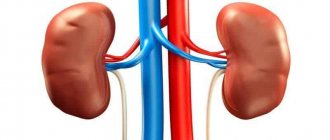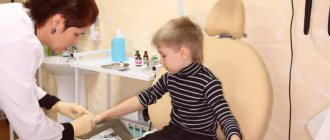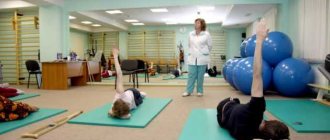Vegetative-vascular dystonia in children is a whole complex of functional disorders of various organs due to a violation of the regulation of their activity by the autonomic system. In medical terminology, this condition is also called neurocirculatory dystonia. Depending on the function of which organ is impaired, the pathology is manifested by the following problems:
- respiratory;
- neurotic;
- cardiac symptoms;
- vascular crises;
- violation of thermoregulation.
Features of the autonomic nervous system in children
- Structural and functional characteristics.
The autonomic nervous system (ANS) in newborns is characterized by its immaturity. The process of formation of the ANS occurs as the child grows up. For this reason, reactions do not proceed as quickly as in adults; there is a gradual maturation of synapses (connections) of the nervous system.
In newborns, spontaneous activity of neurons is observed, since their membrane is more permeable to sodium ions. Biological substances and impulses coming from the central nervous system play an important role in the maturation and formation of the function of peripheral ganglion cells.
The main features of the ANS in the first years of development:
- excessive excitability;
- lack of stability of reactions of the autonomic system;
- severe severity of symptoms and rapid agitation.
In children, especially in infancy, there is instability in indicators of ANS function, especially heart rate and respiration. The stability of autonomic reactions begins to develop in the second year of a child’s life.
- The process of maturation of sympathetic and parasympathetic nerves.
In children of the first years of life, the sympathetic division of the autonomic nervous system plays a key role in regulating the functions of internal organs. The parasympathetic department begins to be involved in reflex reactions from the third month of life. At the age of 3 years, the influence of the vagus nerve is sufficiently pronounced that respiratory arrhythmia begins to appear, but the predominant influence of the sympathetic nervous system persists until the age of 7 years. However, despite the fact that in newborns the tone of the vagus nerve is still weak, during this period the oculocardiac Aschner-Dagnini reflex can be observed.
- The mechanism of tone formation.
In the formation of the tone of the vagus nerve, afferent impulses from various reflexogenic zones, including proprioceptors, play an important role. This is confirmed by the fact that the lack of movement in children is accompanied by insufficient expression of the tone of the vagus nerve.
Important in the formation of the tone of the vagus nerve is the impulse from the baro- and chemoreceptors of the vascular reflexogenic zones. The maturation of the central and peripheral parts of the autonomic and somatic nervous system leads to the formation of the tone of all parts of the central nervous system, including the sympathetic and parasympathetic centers.
To assess the severity of the tone of the ANS sections in children, cardiac reflexes and dermography are used.
- Cardiac reflex - pressure on the eyes for 20-60 seconds causes the pulse to slow, blood pressure to decrease, and breathing to slow. The reflex appears quickly (after 3-5 s) or slowly (after 8-10 s). The effect is considered positive if the impulse slows down by 4-12 beats per minute, and sharply positive - by more than 12 beats.
- Dermographic reflex - irritation of the skin with the help of strokes causes the appearance of white or red stripes after 5-10 seconds. The disappearance of white stripes is observed after 5-12 seconds, while the severity of red stripes begins to decrease after 3 minutes. The intensity of the severity and duration of preservation of white stripes indicate an increase in the tone of the sympathetic part of the circulatory center, and red stripes indicate a decrease in its activity.
Autonomic dysfunction syndrome in children
Autonomic dysfunction syndrome in children. Autonomic dysfunction syndrome: causes and treatment
Autonomic dysfunction in children is not a disease, but a so-called syndrome characterized by a slow progression. It is very easy to suspect this kind of violation. For a competent specialist, in fact, it is enough just to talk with the child’s parents and collect a complete medical history. Autonomic dysfunction syndrome is diagnosed not on the basis of one symptom, but taking into account the entire complex of disorders in the general condition of the small patient. With timely treatment, it usually goes away without a trace.
general information
A combination of functional disorders that are characterized by impairments
neurohumoral regulation of the heart, some organs, blood vessels, and secretion glands is today known in medicine as autonomic dysfunction syndrome. The ICD 10th revision classifies it as a disorder of the central nervous system. Moreover, this syndrome is not considered an independent disease. This pathology is classified as a very common disorder and is confirmed in approximately 80% of the population. Its primary symptoms occur in childhood and adolescence, and pronounced clinical signs develop closer to 20 years. According to experts, representatives of the fair sex are several times more likely to suffer from pathology.
Main reasons
Depending on the hereditary predisposition, autonomic dysfunction syndrome in children may appear due to the following provoking or causative factors:
- Unfavorable course of labor.
- Imbalance at the hormonal level.
- Constant psycho-emotional stress.
- Acute infectious diseases.
- Pathologies of internal organs of a chronic nature.
- Inactive lifestyle.
- Frequent stress.
- Changes in metabolic processes.
- Hypo- and hypersensitivity of central receptors.
- Reduction of the so-called innervation of internal organs and individual vessels (supply of nerve cells).
Pathogenesis of the syndrome
The above etiological factors, as a rule, entail damage to the autonomic nervous system at the cellular, membrane and tissue levels. It is these changes that constitute the morphological substrate of pathology. Autonomic disorders of various structures cause:
Classification
The variability of clinical signs, different levels of autonomic changes, and the numerous etiological factors that provoke the development of these disorders require the identification of separate groups in this pathology. Based on the foregoing, experts propose to classify autonomic dysfunction syndrome into four groups.
- Cardiopsychoneurosis.
- Paroxysmal autonomic failure.
- Autonomic-vascular dysfunction.
- Autonomic-visceral dysfunction syndrome.
Clinical signs
The final diagnosis can only be confirmed if the young patient has the following symptoms.
Autonomic dysfunction syndrome in newborns can be caused by pathology of the perinatal period and birth injuries. Fetal hypoxia, various diseases in the first days of life - all these factors negatively affect the development of the autonomic nervous and somatic systems, as well as the performance of their functions in full. In such children, the syndrome is manifested by digestive disorders (flatulence, frequent regurgitation, decreased appetite), a tendency to colds, and emotional imbalance (moody, increased conflict).
During the period of so-called puberty, the functioning of internal organs and the direct growth of the body, as a rule, outstrip the formation of regulation at the neuroendocrine level. As a result, autonomic dysfunction syndrome in children only gets worse. At this age, pathology manifests itself in the form of regular pain in the heart, psychoneurological disorders (increased fatigue, irritability, decreased memory and attention, high anxiety), and lability of blood pressure. In addition, teenagers often complain of dizziness, problems with bowel movements and changes in the usual color of the skin.
It is noteworthy that autonomic dysfunction syndrome in adults manifests itself somewhat differently. The thing is that in this case the pathology is aggravated by existing chronic diseases, neuroses, gastrointestinal diseases, mechanical injuries and hormonal changes (pregnancy, menopause). Along with the above symptoms, all ailments of a chronic nature become aggravated in adults.
Diagnostics
When primary clinical signs of this pathology appear, it is very important to consult a specialist. For its diagnosis, anamnesis, symptoms, time of their appearance and, accordingly, course are of great importance. Taking into account the different localization of signs of this type of disorder, the doctor must conduct a detailed examination of the small patient in order to differentiate other pathologies that are similar in symptom complex.
Then blood pressure and heart rate are monitored. In order to make a diagnosis of autonomic dysfunction syndrome, some specialists include electrocardiography in the examination, not only at rest, but also during light physical activity. Based on the test results, Doppler ultrasound of the blood vessels of the heart and brain (electroencephalography) is sometimes additionally prescribed.
How can you overcome autonomic dysfunction syndrome? Treatment
First of all, parents should reconsider the child’s lifestyle. He should be provided with an optimal daily routine, feasible physical activity, and a normalized work schedule. You should get at least eight hours of sleep at night. It is extremely important to organize your meals properly. It should be fractional, as balanced and complete as possible.
Children who have been diagnosed with hypotonic autonomic dysfunction syndrome are allowed to drink coffee in the morning; it is advisable to increase the amount of protein and sodium in their diet. It is very important to pay attention to non-drug therapy: massage of the affected parts of the spine, water procedures, acupuncture, physiotherapy.
If the above methods are not effective, the doctor, as a rule, prescribes drug treatment. For any type of pathology, it is recommended to begin therapy with a course of vitamins and sedatives responsible for normalizing excitation and inhibition in the central nervous system. An excellent option are infusions of hawthorn, motherwort, and St. John's wort.
For confirmed hypertensive type of syndrome, tranquilizers (Phenazepam, Seduxen) are prescribed. In the absence of a positive effect, beta-blockers are prescribed (Obzidan, Anaprilin, Reserpine).
In the case of the hypotonic type, treatment, as a rule, begins with drugs responsible for stimulating the nervous system (Sidnocarb).
You should not try to overcome autonomic dysfunction syndrome on your own. Treatment should be prescribed by a doctor after a complete diagnostic examination. Otherwise, the pathology will progress, which can negatively affect the child’s life. Excessive irritability, headaches, fatigue - all these and many other factors will haunt the child every day.
Forecast
Timely detection and treatment of autonomic dysfunction syndrome in 90% of cases leads to the complete disappearance of primary symptoms and restoration of the main functions of the body. Otherwise, incorrect therapy or neglect of specialist help can result in very unpleasant health consequences and adversely affect the quality of life.
Preventive measures
For prevention purposes, it is recommended to adhere to strengthening and health measures. As a rule, it is necessary to change the child’s usual lifestyle. Proper and nutritious nutrition and daily physical activity should be ensured. Parents are recommended to maintain good family relationships, prevent the development of conflict situations, and neutralize emerging psycho-emotional stress. Swimming in sea water, walking in a pine forest, and mountain air have an excellent effect on final recovery.
Conclusion
In this article, we have described in as much detail as possible what autonomic dysfunction syndrome is. The symptoms of this pathology should first of all alert parents and become a reason to contact a qualified specialist. Only a doctor has the right to prescribe therapy. In no case should you self-medicate, because this can only waste precious time.
We hope that all the information presented here will be truly useful to you. Be healthy!
Autonomic dysfunction syndrome in children and adolescents
Autonomic dysfunction syndrome in adolescents and children is a pressing problem in medicine. It is characterized by a variety of clinical manifestations and complaints.
Many teenagers during hormonal changes complain of headaches, weakness, fatigue, and poor health. However, autonomic dysfunction syndrome is not an independent disease, but a syndrome. Quite often it occurs rapidly in childhood and adolescence, and then gradually fades away. At the same time, it can also be a precursor to the development of arterial hypertension, gastritis, peptic ulcer, rheumatism, bronchial asthma, etc.
It is known that the appearance of autonomic dysfunction syndrome in children is facilitated by traumatic brain injuries, frequent infectious diseases, physical and mental overload, and nutritional disorders. The psycho-emotional environment in which the child lives and studies also plays a big role. Physical inactivity and spending long periods of time in front of the computer and TV have a negative impact on the child’s body.
The complaints of a teenager with autonomic dysfunction syndrome are very diverse. Children, as well as their parents, are very frightened by suddenly developing attacks of difficulty breathing, aching pain in the heart, in the abdomen, and a decrease in blood pressure. Many children experience neurotic reactions: sleep disturbance, absent-mindedness, palpitations, increased blood pressure.
Autonomic dysfunction syndrome can occur in the form of crises, during which some people’s blood pressure drops sharply (sometimes to the point of fainting), pale skin, sweating, nausea, and in some cases vomiting are noted. For others, during a crisis, blood pressure rises, tachycardia develops, headaches, anxiety, and chills appear.
Treatment and prevention of autonomic dysfunction syndrome
Autonomic dysfunction syndrome, as a rule, does not require drug treatment. First of all, it is advised to properly organize a regime for the child and provide him with adequate nutrition (including a large amount of fruits and vegetables). Children who are overweight need to limit their consumption of fatty and starchy foods, sweets, and increase physical activity. It is also important to organize the student’s physical and mental stress. If necessary, give up extra classes for a while.
Tempering procedures, morning exercises, physical education, visiting the pool and sauna improve the condition. Adverse psychological factors must be eliminated.
Such general health measures are usually quite sufficient, but in some cases the doctor may prescribe medication. Do not delay visiting a specialist, because the sooner you contact, the lower the risk of serious chronic diseases in your child in the future.
Autonomic dysfunction syndrome in children: myths and reality
Autonomic dysfunction syndrome (AVS) and its manifestations in children still raise a large number of questions, to which there are just as many answers, and not always unambiguous. Suffice it to say that in Internet search engines alone there are 214,000 Russian-language sites dedicated to SVD, and 10,600,000 English-language sites covering issues of disorders of the autonomic nervous system. Let us add that if for 1951-1960. There were only 68 publications, then in 2001-2008 you can find 10,623 publications on autonomic dysfunction (Fig. 1).
The abundance of information on this topic does not exclude the existence of certain myths both among patients and among medical practitioners. In this publication, the authors attempted to determine the essence of SVD in children and dispel the most common myths regarding this problem.
Myth one: SVD is not an independent nosological entity. However, according to the International Classification of Diseases (10th revision) in the class Diseases of the nervous system, in the block Other disorders of the nervous system under code G90.8 there is a definition of Other disorders of the autonomic (autonomic) nervous system, which means SVD.
Myth two: SVD is an acquisition of the 20th century. In fact, the study of functional pathology, manifested by cardiac disorders, dates back to the 19th century, when in 1871 Da Costa Jacob Mendez (1833-1900), an American physician, described the excitable heart of young soldiers participating in the American Civil War, called Da Costa syndrome. In our country, the foundations for the study of the physiology and clinic of the autonomic nervous system were laid by such outstanding scientists as S. P. Botkin, I. M. Sechenov, I. P. Pavlov, L. A. Orbeli, A. P. Speransky, K. M. Bykov. At the beginning of the twentieth century (1916), the Russian scientist V.F. Zelensky described the symptoms of cardiac neurosis in Clinical Lectures. Modern ideas about the organization of the autonomic nervous system, as well as clinical vegetology, we, indeed, largely owe to scientists who worked in the twentieth century. The attending physician of the 21st century, having encountered the problems of autonomic dysfunctions, cannot do without the works of A. M. Vein and N. A. Belokon, in which one can find explanations for almost all clinical cases.
Myth three: the basis of autonomic dysfunction is the increased activity of one department due to the suppression of another. This idea - the principle of scales - reflects the rule of double innervation, in which the sympathetic and parasympathetic systems have opposite effects on the working organ (dilation and constriction of blood vessels, increased and slowed heart rate, changes in the lumen of the bronchi, peristalsis and secretion by the organs of the gastrointestinal tract). However, under physiological conditions, an increase in the effects of one of the departments of the autonomic nervous system leads to compensatory tension in the regulatory mechanisms of another, which transfers the system to a new level of functioning, restoring the corresponding homeostatic parameters. The most important role in these processes is played by both suprasegmental formations and segmental autonomic reflexes. In a state of overstrain, failure of adaptation, the regulatory function is disrupted and, accordingly, increased activity of one department does not lead to corresponding changes in the other, which is clinically manifested by symptoms of autonomic dysfunction.
Myth four: stress plays a leading role in the etiology of autonomic dysfunctions. In fact, SVD is polyetiological, and among the many causes, both congenital and acquired features can be distinguished:
hereditary and constitutional features of the activity of the autonomic nervous system (autosomal dominant type of inheritance)
unfavorable course of pregnancy and childbirth, contributing to impaired maturation of cellular structures of the suprasegmental apparatus, natal injuries of the central nervous system and cervical spine (hypertensive-hydrocephalic syndrome, vertebrobasilar insufficiency)
psycho-emotional characteristics of the child’s personality: increased personal anxiety, depressive disorders, hypochondriacal fixation on one’s own health
VSD syndrome
Autonomic dysfunction syndrome, VSD syndrome, is not a disease, which is why the treasured “syndrome” is used in its name. This is a complex of symptoms that appear against the background of improper functioning of parts of the autonomic nervous system, disruption of the alternation of excitation and inhibition processes in various organs. And since the ANS, without the help of our consciousness, controls the functions of absolutely all systems, organs and tissues, its violations can provoke manifestations from any organ. This is where the varied symptoms of VSD come from: heart pain, breathing disorders, digestive disorders.
20VSD.jpg" /%
What is VSD syndrome and what are its causes?
Vegetative-vascular dystonia or VSD syndrome is not considered an independent disease. According to the ICD 10 classification, it is classified as “disorders of the nervous system” and “disorders of the autonomic nervous system.” By this we can judge that all unpleasant symptoms are just a consequence of the malfunction of the sympathetic and parasympathetic divisions of the ANS. And all this is confirmed during the examination: no pathological changes are detected in the organs, the results of all tests are within normal limits.
The reasons for the development of autonomic dysfunction syndrome are not exactly known. However, experts have noted multiple background conditions that contribute to its appearance. First of all, this is a hereditary predisposition: the risk of developing VSD in people whose blood relatives have been diagnosed with the same disease increases by about 20%. Also favorable conditions for the development of neurocirculatory dystonia can be:
- severe pregnancy in the mother, birth injuries in the child
- habit from childhood to a sedentary lifestyle
- bad habits
- constant psycho-emotional stress: at work, in the family
- constant physical or mental fatigue, which is often associated with study or the chosen type of professional activity.
Multiple provoking factors have also been identified, the superposition of which on a favorable background can become the start for the development of VSD syndrome. These factors include:
- damage to parts of the ANS under the influence of infectious pathogens or due to trauma, tumor processes
- diseases of the endocrine system leading to hormonal imbalance, as well as, which is typical for women, hormonal surges during menstruation, pregnancy or menopause
- chronic or acute infectious diseases with the formation of foci of infection
- frequent stressful situations
- disruption of normal sleep and rest patterns
- short-term physical or mental stress
- parasitic or infectious intoxication of the body, as well as work in hazardous industries
- some other circumstances: operations, anesthesia, sudden climate change, overweight or underweight, osteochondrosis of any part of the spine and others.
An interesting fact is that autonomic dysfunction syndrome more often worries women, although this may be due to their frequent hormonal surges, the greater vulnerability of the body compared to men, as well as disruption of the rhythm of life associated with pregnancy, childbirth and caring for a newborn.
In most cases, the foundations for impaired autonomic regulation are laid in childhood, and its first manifestations most often occur in high school, student years, and the beginning of independent life. That is, the syndrome of vegetative-vascular dystonia often manifests itself at the age of 15-20 years (school and student periods), as well as 20-40 (entering an independent life, trying to start a family, first difficulties at work, starting your own business, and so on). It is during this period of a person’s life that there is maximum physical and emotional stress, the maximum number of stressful situations - and all this is a good impetus for the development of vegetative-vascular dystonia.
Interesting facts about VSD syndrome
VSD is referred to in many sources as a disease of the 20th-21st centuries. Indeed, in recent decades there has been a tendency towards its spread. The rhythm of life of a modern person creates the best conditions for its development: lack of sleep, the pursuit of money, constant stress. However, apparently, VSD was encountered much earlier, only under other “names” - “spleen”, “spleen”, “pale illness”.
Moliere, Balzac, Flaubert, in describing the appearance and behavior of their heroes and heroines of “noble blood,” indicated the very real signs of the presence of disorders of autonomic regulation. They were pale, lethargic, constantly fainted, clutched their chests, had no interest in life - and these are typical symptoms of psychovegetative syndrome. And the treatment of “noble” ladies and gentlemen consisted of rest, a change of environment and positive emotions - the most effective ways to control and prevent attacks of VSD. Why were none of these descriptions suitable for ordinary peasants and workers? Everything is simple: constant stay in the fresh air, high physical activity from early childhood, absence of “palace intrigues” - everything is quiet, measured and relatively calm. In a strong body the syndrome does not progress.
Further - more interesting. At the end of the 19th century, doctors were concerned about the constant heart pain in military personnel, which, however, went away on its own and did not lead to serious consequences. No pathological changes were found in the heart muscle. This “disease” was called irritable heart. It was later explained that "irritable heart" is only a cardiac component of the autonomic dysfunction syndrome.
Later, an American physician noted the connection between heart pain and other accompanying symptoms (digestive disorders, breathing problems), as well as previous infectious diseases. The description of this phenomenon appeared under the name “Da Costa syndrome”. During the First World War, independent research by various doctors gave rise to new names for a “disease” similar to VSD syndrome - painful chest, effort syndrome, soldier’s heart.
S. Freud also studied the syndrome of autonomic dysfunction in adults. He considered depression, anxiety, and disorders in the psycho-emotional sphere to be the basis for heart pain, and classified cardiac manifestations as secondary symptoms. This assumption led to the classification of pathology as neurotic diseases - anxiety neurosis and neurasthenia. In the middle of the last century, this symptom complex was called cardiac neurosis. Further research finally replaced vegetative-vascular dystonia from the list of nervous diseases and proved the advisability of classifying it as a syndrome, that is, a stable complex of symptoms.
Difficulties in diagnosing and treating VSD syndrome
Making a diagnosis of vegetative-vascular dysfunction is difficult. And all this due to the lack of possibility of a thorough study of the parts of the autonomic nervous system. In the vast majority of cases, the assessment of the patient’s condition is subjective and is determined by the presence of certain symptoms, as well as the experience and worldview of the doctor. For a correct diagnosis, differential diagnosis is extremely important: first, the doctor must exclude the possibility that the patient has a true disease of the internal organs.
Due to poor knowledge of the nervous system, the treatment of VSD syndrome is also difficult. In most cases, it comes down to alleviating symptoms and eliminating provoking factors. In recent years, efforts have been made to “cure” mild and moderate severity of vegetative-vascular dystonia syndrome using non-drug methods. There are many techniques, the purpose of which is to teach the patient to control his emotions and cope with attacks. An important component of treatment is also the maintenance of normal physical activity, proper work and rest routine, as well as the elimination of provoking factors of a psycho-emotional nature.
Sources: www.syl.ru, kudesnitsa.ucoz.ru, www.lvrach.ru, net-vsd.ru
Next articles:
What is VSD?
Vegetative-vascular dystonia (VSD) is symptoms of various clinical manifestations that affect various organs and systems. As a result, deviations occur in the structure and function of the central and/or peripheral parts of the autonomic nervous system.
Vegetative-vascular dystonia is not an independent nosological pathology, but together with other pathogenic stimuli it can provoke the development of many diseases and conditions, most often based on psychosomatics (arterial hypertension, coronary heart disease, bronchial asthma, peptic ulcer, etc.). Autonomic changes determine the development and course of many diseases in childhood. In turn, any disease, including somatic disease, can potentiate autonomic disorders.
Classification of vegetative-vascular dystonia
Until now, a traditional classification of vegetative-vascular dystonia has not been developed. When formulating a diagnosis, as a rule, the following are taken into account:
- causal factors;
- type of autonomic disorders (vagotonia, sympathicotonia, mixed);
- prevalence of autonomic disorders (general, systemic or local form);
- systems and organs that are most actively involved in the development of pathology;
- functional state of the autonomic nervous system;
- severity (moderate, moderate, severe);
- nature of the disease development (periodic, constant, paroxysmal).
Symptoms of VSD in children
Vegetative-vascular dystonia is characterized by numerous, often striking subjective manifestations that do not correspond to the weaker objective signs of this organ pathology. The clinical picture of vegetative-vascular dystonia largely depends on the direction of autonomic disorders.
In children with this pathology, the following hypochondriacal complaints are identified:
- fatigue;
- decreased ability to work;
- memory problems;
- sleep disorder (difficulty falling asleep, drowsiness);
- lethargy;
- indecision, timidity;
- depressive state.
A decrease in appetite may be detected in combination with excessive body weight, poor tolerance, poor tolerance to stuffy rooms, a feeling of cold or lack of air, periodic deep breaths, a feeling of a “lump” in the throat. Vestibular disorders are also noted: dizziness, pain in the legs (usually at night) or in the abdomen, nausea, unreasonable marbling of the skin, acrocyanosis, increased oily skin, a tendency to retain fluid, turning into swelling under the eyes, frequent urination, excessive salivation, spastic constipation , allergies.
Cardiovascular disorders are manifested by pain in the heart, bradyarrhythmia, a tendency to lower blood pressure, an increase in heart size, and a decrease in the tone of the heart muscle. Electrocardiography reveals sinus bradycardia (bradyarrhythmia).
- Sympathicotonia
Children with sympathicotonia are characterized by:
- mood variability;
- increased sensitivity to pain;
- quick distraction from classes;
- various neurotic conditions.
With sympathicotonia, hot flashes are often complained of. An asthenic body type with increased appetite, pale and dry skin, strong white dermographism, cold feet and hands, numbness and paresthesia in the morning, causeless fever, poor heat tolerance, and polyuria are also often observed. There are no respiratory problems, vestibular disorders are rare.
Cardiovascular disorders appear in combination with tachycardia, high blood pressure with a normal heart size and loud sounds. The ECG often shows sinus tachycardia.
Video: Symptoms of VSD in a child
Symptoms of VSD
Since the disease affects many systems of the human body, vegetative-vascular dystonia manifests itself in children with various symptoms. In modern medical literature, approximately 30 different syndromes and about 150 signs of the disease are described. Parents in this situation should be alert to the following manifestations:
- frequent mood swings, hysteria, anxiety;
- decreased motor activity of the baby;
- increased fatigue;
- sleep problems such as insomnia or excessive sleepiness;
- disruption of the sebaceous glands, acne in adolescence;
- dyspepsia (nausea, diarrhea), abdominal pain, loss of appetite;
- shortness of breath, breathing problems;
- headaches, dizziness;
- memory problems;
- marbled skin syndrome.
It is especially important to pay attention to the listed signs of vegetative-vascular dystonia in young children. They are not always able to describe the existing unpleasant sensations, this or that discomfort. When visiting a doctor, you must try to reliably describe the existing problems so that the specialist can distinguish VSD from other diseases.
Causes of VSD in children and risk groups
External irritants may cause:
- stressful situations in the family;
- inclusion of new foods in the diet;
- mental stress due to the large amount of information supplied with the curriculum at school;
- frequent updating of household items;
- poor adaptation to the accelerating pace of life.
Additionally, doctors point to a genetic predisposition, but this factor only increases the chances of developing the disease and never acts as the main reason for the appearance of VSD in children.
The risk group includes children born as a result of problematic births, premature babies, as well as those whose mothers suffered from infectious diseases during pregnancy. Possible damage to the central nervous system and developmental abnormalities during pregnancy and early childhood not only create various psychological problems, but also VSD.
One of the most common causes of psychological trauma is a difficult psychological situation in the family. The risk of developing the disease increases tenfold in families where there is one parent, parents abuse alcohol/drugs, are isolated from children, or are overprotective.
Allergic reactions, poor climate or weather conditions, and unfavorable environmental situation in the region also increase the risk, especially against the background of psycho-emotional stress, poor nutrition or hormonal disorders.
Diagnosis and identification of the causes of the disease is complicated by the fact that children perceive the disease very subjectively, and their complaints are sometimes far from the actual development of the pathology. For example, when a child has a headache, he may simultaneously complain of abdominal pain and vice versa.
Diagnosis of VSD in children
When identifying the above symptoms of vegetative-vascular dystonia in a child, it is recommended to go to the clinic, where the following doctors will check him:
- pediatrician;
- cardiologist;
- ophthalmologist;
- neurologist;
- ENT;
- endocrinologist;
- gynecologist (girls);
- urologist (boys).
Doctors diagnose VSD after the assumption of damage to organs of a different nature has not been confirmed. A set of instrumental studies is prescribed: electrocardiography, Dopplerography, rheovasography, rheoencephalography. These procedures help to localize damage to the autonomous system.
Treatment of VSD in children
Since the child is very sensitive to various stresses, he needs to be protected from all kinds of experiences. Peace, mutual respect and love should rule in the family, and one should in every possible way refrain from any emotional influence. Sometimes even positive, but extremely strong, emotions are harmful.
Children with VSD need to plan weekdays and weekends, balance physical activity with rest. It is extremely important to maintain a positive mood, to prefer non-pharmacological methods of treatment, but, as a last resort, not to abandon traditional methods of influence.
You should definitely pay attention to the dosage prescribed by your doctor - you should not give the full dose, since the desired effect is achieved gradually.
Children suffering from VSD should be screened regularly, at least once every six months, especially during the off-season.
Non-pharmacological therapeutic effects
Overuse of sedatives can cause unnecessary health problems for your child. Therefore, it is always better to start treating VSD in children with non-drug methods of influence. In fact, this therapy is considered the main one.
The most frequently given recommendations are:
- regular exposure to fresh air;
- reducing the workload (lessons are completed intermittently);
- healthy nutritious diet;
- reducing the time spent by the child on the computer and other electronic devices associated with information flows (cell phone, TV);
- drinking clean water;
- sleep at least 9 hours;
- music lessons;
- therapeutic massage and electrophoresis;
- acupuncture;
- psychotherapy;
- water therapy;
- physiotherapy.
Herbal medicine is also recommended - the use of lemon balm (neurotic form of the disease) and chamomile (dyspepsia). Physiotherapeutic electrophoresis with bromine (used in the collar area) and electrosleep are effective.
Other herbs that may help treat VSD in children:
- Siberian ginseng;
- Aralia;
- coltsfoot;
- ginseng;
- valerian;
- hawthorn.
A good aid in the treatment of VSD in children is vitamin complexes.
Among the useful sports:
- tennis;
- swimming;
- skates;
- skiing;
- outdoor games.
Drug treatment
Medicines prescribed by a doctor are not always taken from a group of drugs with non-pharmacological effects. If a child is able to lead a full life, doctors most often prescribe a balanced combination of medications.
Drug therapy for VSD in children may include the following drugs:
- blood circulation stimulants;
- neuroprotectors;
- antioxidants;
- blockers;
- antidepressants;
- tranquilizers.
All medications are prescribed by a doctor individually. There is no “universal” set of medications. Self-medication should be avoided, as this can lead to irreparable consequences for the child’s health.
Antidepressants and tranquilizers are prescribed only in extreme cases, most often the emphasis is on sedatives.
Prevention of VSD in children
Preventive measures include not only the correct daily routine and normalization of the psychological climate in the family. Doctors recommend balancing the patient’s daily diet. In particular, you need to use more legumes, berries, grains, fruits and vegetables, vegetable oils, nuts and dried fruits.
Reduce your intake of the following foods:
- table salt;
- fatty meats and fish;
- sodas;
- sweets;
- tea and coffee (if you have a tendency to hypertension).
The comprehensive development of the child prevents the progression of the disease. We need to focus on good nutrition and recovery measures. Sometimes it is worth paying attention to visiting a family psychologist. The set of proposed measures will eliminate the recurrence and progression of attacks and, in the long term, completely normalize the child’s health.
Video: Prevention of VSD in children
Vegetative vascular dystonia in children is a common disease that is difficult to diagnose. The essence of this disease is that the blood vessels reduce their activity, which leads to malfunctions and disruptions in the functioning of various body systems.
This disease is especially common in children and adolescents. Children's autonomic system is still quite weak, so it is susceptible to various failures.
Modern doctors try to identify this disease as early as possible and begin treatment for VSD in children, but in some cases it is unacceptable.
It is much easier to eliminate the cause of the child’s discomfort than to immediately begin treatment for an extensive syndrome.
Where do autonomic disorders come from?
The development of VSD in children is most often associated with hereditary factors and occurs as a result of disturbances in the functioning and structure of individual parts of the autonomic system on the part of the mother.
It is known that complicated pregnancy and difficult childbirth contribute to the appearance of vascular dystonia in newborns. In these cases, the baby's health is approaching the risk zone. A clear cause for concern are:
- fetal hypoxia,
- toxicosis,
- birth injuries,
- intrauterine infection,
- prolonged or rapid labor.
Factors in the occurrence of vegetative-vascular syndrome in children and adolescents under 19 years of age are often endocrine, infectious, somatic and neuroinfectious diseases, and allergies.
The vegetative system of a growing organism is unstable and can fail due to many factors.
Dystonia can be caused by common infectious diseases such as caries, chronic tonsillitis, pharyngitis. Traumatic brain injuries, anemia and even minor constitutional anomalies can easily provoke symptoms of VSD.
Psychotraumatic factors play an important role in the occurrence of vegetative syndrome in adolescents:
- school and family conflicts,
- overprotection,
- psychological neglect of the child,
- severe regular stress,
- excessive workload at school.
Even climate features: negative meteorological conditions, environmental pollution can provoke disorders and will require treatment in the future.
Vegetative-vascular syndrome can often appear during active growth up to 19 years of age, when a large functional load is carried out with relatively low mobility of the nervous system of adolescents.
During this period, both physical inactivity and physical fatigue can be provocateurs of VSD. Neglect of the correct regime from an early age, poor nutrition and sleep destabilize metabolism. And hormonal changes in adolescents during puberty are a real catalyst for the appearance of VSD symptoms.
Prevalence
According to official statistics, 12-25 percent of children suffer from this disease, but the actual incidence rate is much higher. VSD is an elusive diagnosis.
The manifestations of this disease are often confused with the manifestations of other diseases or with ordinary fatigue. However, VSD is a disease that should be diagnosed and the best way to get rid of it should be determined.
This disease has several names. It is also called neurocirculatory dystonia and autonomic dystonia syndrome.
Some doctors tend to consider VSD not a disease, but a special condition of the body, bordering between health and pathology.
Causes of the disease
Most often, VSD is inherited by the baby. If parents had certain disorders in the functioning of the cardiovascular system, most likely, symptoms of VSD will also appear in their children.
Also, the appearance of vegetative-vascular autonomic dystonia in children can be caused by various birth injuries, especially head injuries. Birth injuries may not show any other signs in the future, but simply give impetus to the development of vascular dystonia in the child. Traumatic brain injuries received in childhood can influence the onset of this disease.
Frequent illnesses in early childhood can also provoke the appearance of symptoms of vegetative-vascular dystonia in children, which can be related not only to the cardiovascular system, but also be associated with belching, dysbacteriosis and other viral diseases that weaken the baby’s autonomic system and immunity.
Not only physical problems, but also psycho-emotional factors: stress, nervous breakdowns, emotional overstrain can cause the appearance of this pathology.
Forecast
In most cases, neurocirculatory dystonia in children has a favorable prognosis. This disease does not lead to serious heart pathologies. However, symptoms of VSD in children can significantly complicate their lives. Poor health, increased fatigue, weakness - all this leads to decreased activity, decreased academic performance, and poor appetite.
A healthy lifestyle will help your child cope with emerging problems. In this case, drug therapy is not necessary. By following all of the above recommendations, you can quickly cope with the symptoms of vegetative-vascular dystonia.
Did you like the article? Save it!
Still have questions? Ask them in the comments! Cardiologist Mariam Harutyunyan will answer them.
Ivan Grekhov
Graduated from the Ural State Medical University with a degree in General Medicine. General practitioner
Classification
According to the nature of the disease, VSD is divided into varieties:
- Permanent is a chronic form of the disease that occurs without surges or changes.
- Paroxysmal. It occurs with periodic periods of exacerbation. Between these periods it is practically unnoticeable.
- Mixed. Possesses characteristics of both of the above types.
- Hidden. It appears only after strong provocative factors.
According to the form, VSD is divided into the following types:
- Cardiac. Changes in cardiac function are observed in the form of arrhythmia (bradycardia, tachycardia, extrasystole). With this form of the disease, children often complain of lack of air, a feeling of cardiac arrest, and heart pain.
- Hypotensive. Weakness in the muscles, low blood pressure in the child, lightheadedness, paleness and coldness of the skin.
- Hyperthetic. Increased blood pressure, dizziness, headaches, rapid heartbeat, increased sweating, redness of the facial skin.
- Mixed type. They are characterized by the manifestation of all the above symptoms to varying degrees.
In children and adolescents with VSD, psycho-emotional changes are often observed, characterized by specific manifestations.
For example, such as:
- apathy, mood swings;
- feeling of anxiety, fear;
- chronic fatigue;
- depressive states;
- loss of appetite;
- isolation;
- insomnia, worsening sleep.
Disturbances in the digestive system (vomiting, changes in stool, pain in the abdomen), respiratory system (breathing difficulties, shortness of breath), and genitourinary system (nocturnal enuresis) may also be observed. There may also be signs of changes in thermoregulation (temperature increases during the day and decreases at night for no reason).
The main feature of vascular dystonia in a child is the pronounced inconstancy of symptoms and complaints. Vegetative crises can occur sporadically or be repeated daily due to stressful situations, excessive physical activity, sudden changes in weather and other factors.
General health usually does not worsen.
Prevention and prognosis
All methods of preventing vascular dystonia in children and adolescents come down to minimizing the influence of risk factors, harmonizing development and using general strengthening measures. All children of different years who have been diagnosed with vegetative-vascular dystonia are required to be registered at a dispensary and undergo regular preventive treatment.
We recommend watching:
We recommend reading:
VSD and elevated temperature
Previous article
Auto-training technique for neuroses
Next article
Diagnosis of the disease
An accurate diagnosis of VSD can be made to a child only after he reaches the age of twelve. If he has the symptoms listed above, the following tests must be carried out:
- electroencephalogram;
- electrocardiogram;
- Holter monitoring;
- EchoEG;
- Pharmacological, orthostatic tests to assess autonomic reactivity.
A child with suspected VSD needs to be examined by a pediatrician, neurologist, cardiologist, endocrinologist, ophthalmologist, otolaryngologist, gastroenterologist.
During the examination, other pathologies that are characterized by similar clinical manifestations should be excluded: mental illness, asthma, arterial hypertension, infective endocarditis, rheumatism, etc.
Treatment of the disease
To decide how to treat VSD in children, factors such as the nature and etiology of the autonomic disorders present should be taken into account. When treating vegetative-vascular dystonia in children, preference is given to non-drug methods of therapy.
To improve the child’s condition, it is necessary:
- Normalize your daily routine, sleep and rest patterns.
- Limit traumatic influences, eliminate stressful situations at school and family.
- Provide adequate physical activity, walks in the air.
- Follow a diet with a minimum content of salty and spicy foods, tonic drinks, and smoked foods.
The diet should contain healthy foods that contain all the microelements and vitamins the body needs.
In addition, methods of psychological correction and auto-training are used, as well as various physiotherapeutic procedures: electrophoresis, magnetic laser therapy, electrosleep, water treatments (circular shower, pine, hydrogen sulfide and iodine-bromine baths), herbal aromatherapy, acupuncture, massage.
Various methods of psychotherapy are important - family psychotherapy, different methods of relaxation.
It is very important to adhere to a daily routine: sleep for at least eight hours, reduce training loads, walk in the fresh air, limit the use of TV and computer.
A child suffering from dystonia needs sports activities with moderate intensity: gymnastics after sleep, swimming, skiing, systematic skating and cycling, walking, hiking.
If drug treatment is ineffective, the child is prescribed medications - nootropic drugs, sedatives made from various medicinal herbs, etc. In case of severe manifestations of VSD, tranquilizers, antidepressants, antihypertensive and antiarrhythmic drugs can be prescribed.
Traditional medicine that can alleviate the condition of vascular dystonia:
- tea from mulberry branches;
- pine needle tea;
- infusion of buckwheat flowers;
- a decoction of valerian root and dill seeds;
- a decoction from a collection of medicinal herbs (immortelle, St. John's wort, chamomile), as well as from birch buds, to which you can add natural honey;
- before bed – warm milk with honey.
The diet of a sick child should include foods rich in potassium salts and magic.
The following products contain them:
- porridge (buckwheat and oatmeal);
- legumes (beans, soybeans, peas);
- parsley;
- nuts;
- onion;
- salad;
- carrot;
- eggplant;
- dried apricots;
- raisin.
Treatment of the disorder
When choosing methods for eliminating VSD syndromes in children, doctors first of all take into account the nature of the disorders. Symptoms are eliminated mainly through therapy - without the use of medications.
The main recommendations for children and adolescents with dystonia are:
- normalization of rest,
- adherence to the daily routine,
- sufficient sleep
- moderate physical activity,
- exclusion of traumatic factors,
- visiting a family psychologist.
In the treatment of childhood vegetative-vascular dystonia, a significant effect is provided by massage of the cervical spine and general massage, various electrophoresis and galvanization.
Water procedures are considered very useful: Charcot's shower, fan and circular shower, swimming, taking turpentine, carbon dioxide and pine baths. Such procedures have an effective effect on all symptoms confirming the diagnosis.
VSD is not dangerous in itself, however, it is an alarming signal of a possible risk of potential diseases. A special role is played by timely detection and effective treatment of endocrine, somatic disorders and focal infections.
Preventive measures and prognosis
Prevention of VSD involves preventing the influence of potential risk factors, carrying out general strengthening measures and harmonizing the child’s development. A child who has signs of VSD should be registered with specialists and systematically receive the necessary preventive treatment.
Consistently carried out prevention, timely diagnosis, as well as competent treatment of autonomic disorders make it possible to significantly weaken or completely eliminate all manifestations of VSD in children. In the absence of proper control by specialists, the baby may develop a psychosomatic pathology that can cause physical and psychological maladaptation of the child.
By the way, vegetative-vascular dystonia is well covered in a video broadcast by a famous doctor, we recommend watching:
Independent diagnosis and prescription of treatment for vascular dystonia is strictly contraindicated. If symptoms and signs of this disease appear, parents should immediately take their child to the doctor. The parents themselves must provide the child with the most favorable and comfortable conditions so that this pathological condition can be cured.
Behind the medical term vegetative-vascular dystonia (neurocirculatory dystonia, neurocirculatory asthenia, psychovegetative syndrome, vegetative neurosis) is a complex of interdependent disorders in the functioning of a large number of organs and systems of the body. This is a multifaceted disease characterized by an imbalance in the autonomic regulation of organs, blood vessels, and metabolic processes as a result of primary or secondary morphofunctional changes in the autonomic nervous system.
Prevalence of the syndrome
First of all, parents should understand that most modern doctors are not inclined to consider VSD in children a disease. Rather, this is a borderline state, a reason to be on guard and pay special attention to the child’s health.
Practicing pediatricians are convinced that signs of vegetative-vascular pathologies are present to one degree or another in 50-70% of children and adolescents. These are complex symptoms that indicate functional disorders of a number of systems in the body associated with disruption of the autonomic nervous system.
Simply put, in most modern children, vital activity is clearly reduced due to malfunctions in the body.
At the same time, VSD syndrome most often manifests itself in adolescents and children aged 5 to 8 years. In newborns, such a diagnosis is less common - in infants, identifying symptoms is complicated by the peculiarities of metabolic processes.
Interestingly, it is predominantly girls who are prone to such disorders, so parents of daughters should be especially careful.
Vegetative dystonia is sometimes the cause of the development in a child of such pathological conditions as bronchial asthma, arterial hypertension, and gastric ulcers. It should be noted that various infectious and somatic diseases can intensify the symptoms of dystonia in a child, so it is extremely important to carefully treat them.
Causes of vegetative-vascular dystonia in children
It is characteristic that VSD syndrome mainly affects children who were born and raised in an urban modern environment. In many studies, a control group of adolescents was found to lack adequate physical activity and have a sedentary lifestyle. Hobbies of computer games and watching television programs do not remain aside either. The more time a child spends in front of a TV screen or computer monitor, the higher the chances that he will develop vegetative shifts with the formation of a vascular dystonia complex of one type or another. The occurrence of the disease also contributes to:
- hereditary predisposition;
- suffered serious illnesses;
- changes in the body's hormonal levels;
- bad habits;
- malnutrition with a deficiency of certain vitamins and minerals,
- excessive workload at school, frequent stress.
Signs of vegetative-vascular dystonia in children
The first signs may appear at the age of 6 years. But the largest number of diagnosed cases occurs in adolescence. This is due to the fact that existing autonomic abnormalities in the development of the peripheral nervous system are affected by hormonal shifts.
VSD manifests itself in children with a variety of unpleasant symptoms. Already at the age of 7–8 years, 76% of children can complain of headaches. For children 10–12 years old, complaints of dizziness are more common (32% of children). It can occur soon after sleep, with a sudden change in body position, or with long breaks between meals. 45% of children note the problem of increased fatigue during physical activity. In 41% of cases, memory loss, distractibility, absent-mindedness, and deterioration in performance appear. But the largest number of complaints relate to the group of emotional disorders. 73% of children have emotional lability, tearfulness, short temper, and mood swings. Negative factors such as anxiety, emotional tension, and conflict are also often noted.
Attacks and exacerbations can be triggered by any changes in the child’s environment - a change in weather, renovations in his room, or a bad grade received.
When making a diagnosis, it is necessary to focus on the main set of leading symptoms, which may indirectly indicate damage to one or another part of the autonomic nervous system. There are three main types:
1. Vegetative-vascular dystonia of the hypertensive type (or sympathicotonic type). 2. Vegetative-vascular dystonia of the hypotonic type (or vagotonic type). 3. Mixed form of the disease.
In almost all types of damage, there are signs of weakness of the sinus node of the heart muscle. This may be manifested by periodic pain in the left half of the chest, palpitations, and increased heart rate. All children with VSD, regardless of the clinical course, have a general maladaptation syndrome - increased fatigue, weakness, lethargy, decreased performance.
With the development of hypertensive VSD, a teenager suffers from:
- frequent headaches;
- increased nervous excitability;
- difficulty going to bed;
- absentmindedness;
- difficulties with memorizing the material being studied.
Pain in the heart area may be bothersome. A distinctive characteristic is an increase in blood pressure to 140/80 mm Hg.
In the hypotonic type of the disease, symptoms of insufficiency of cerebral blood supply come to the fore. These may be the following signs:
- tearfulness and constant mood swings;
- dizziness and muscle weakness;
- headaches are diffuse;
- constant drowsiness and apathy.
Heart pain occurs mainly during physical activity. The child has bradycardia and pale skin. Blood pressure often stays within 110/70 mmHg.
With a prolonged course of VSD, these symptoms may be accompanied by signs of secondary damage to internal organs and systems. The innervation of the mucous membrane of the stomach and gallbladder is often disrupted. Problems arise with lack of appetite, constant congestion in the biliary tract, and stool disorders.
Vegetovascular dystonia: causes of dysfunction
The causes of vegetative dystonia syndrome are diverse, and this anomaly can arise not only as a result of the influence of any one factor, but also become a consequence of the combined influence of internal and external conditions.
In the etiology of VSD, the dominant position is occupied by hereditary and constitutional features of the autonomic nervous system, the so-called hereditary factors. Signs of vegetative dystonia can be detected in early childhood if the mother has an unfavorable course of pregnancy and childbirth.
- Of the acquired causes of the formation of autonomic dystonia syndrome, damage to the central and peripheral nervous system is of no small importance . VSD can be caused by endocrine disorders, for example: diabetes mellitus, hypothyroidism. Dysfunction of the autonomic nervous system is observed when the immune system malfunctions, for example: with amyloidosis.
- Intoxication and drug intoxication can give rise to the syndrome of vegetative dystonia Some infectious diseases, for example: herpes infections, AIDS, syphilis, are accompanied by dysfunction of the autonomic nervous system.
- The onset of VSD can be triggered by prolonged psycho-emotional stress, mental overload, and accumulated physical fatigue. Chronic stress or sudden intense shock can initiate pathological autonomic reactions. Another reason for VSD is physical inactivity, prolonged work on the computer, and excessive involvement in online games. This lifestyle leads to depletion of the resources of the nervous system, which gives rise to various neurotic manifestations.
- Often, vegetative dystonia syndrome is determined in individuals who have a specific personality profile: suspicious, impressionable, emotionally unstable, anxious people. Unhealthy autonomic reactions also occur in people who are unable to express their feelings in a constructive way and become stuck in negative ruminations. Autonomic dystonia syndrome is present in people who are depressed.
- Often, aggravation of the symptoms of VSD is observed with hormonal imbalance, which often occurs during puberty of a teenager, pregnancy, and the menopausal phase. A severe course of vegetative dystonia syndrome is observed in people suffering from alcohol dependence. Smoking also negatively affects the functioning of the autonomic nervous system. Vegetative instability manifests itself as pathological reactions when weather conditions change and when work and rest regimes change.










